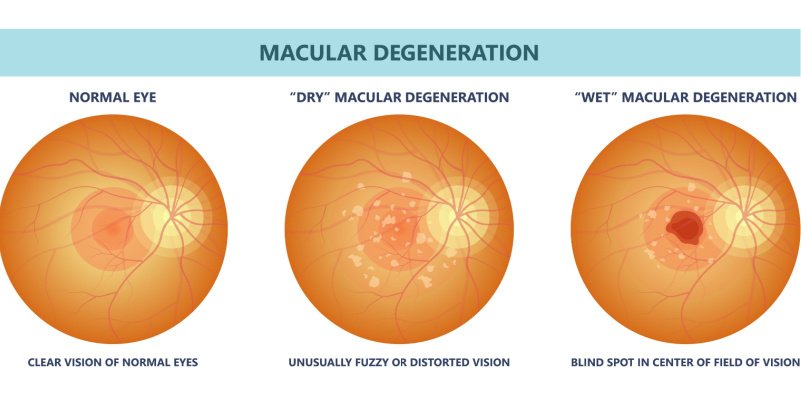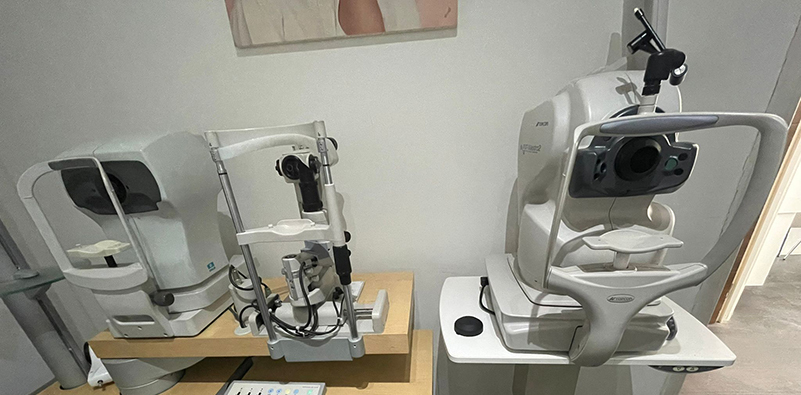Everything you need to know about Age-Related Macular Degeneration (AMD)
Age-related macular degeneration (AMD) is an eye condition that can significantly impact your vision. It’s estimated to affect almost 1.5 million people in the UK, and while it’s most common in people over 55, younger people can develop it as well. By understanding the risks, symptoms, and treatment options for AMD, you can make informed decisions about your eye health.
What is age-related macular degeneration?
Age-related macular degeneration (AMD) occurs when the macula – a small part of the back of the eye responsible for detailed, central vision, deteriorates over time. There are two types of AMD: wet and dry. Dry AMD is the most common type and progresses slowly, leading to a gradual loss of central vision. Wet AMD, on the other hand, is less common but more severe. It occurs when abnormal blood vessels grow beneath the macula and can lead to rapid vision loss. Although the cause of AMD is unknown, several risk factors may contribute to its development, such as exposure to too much UV light, old age, family history, smoking, and poor diet.
Common symptoms of AMD
There are a variety of age-related macular degeneration symptoms, and it’s important to know what to look out for. Blurred and distorted vision, difficulty reading fine print, and straight lines appearing wavy are some of the hallmarks of the onset of this degenerative condition. Other symptoms include light sensitivity, difficulty recognising faces, and difficulty watching TV or driving.
If you’re experiencing any of these symptoms, booking an eye exam with us as soon as possible is important. As AMD advances, it can eventually cause you to lose your central vision – what you see right in front of you – making day-to-day activities and tasks very difficult.
Detection of AMD
Regular eye examinations are vital for early detection of various eye conditions, including age-related macular degeneration. Fortunately, advancements in technology like the Optical Coherence Tomography (OCT) test make diagnosing and managing such eye conditions at a much earlier stage easier.
Much like an ultrasound, but using light waves instead, this retinal scan can generate detailed, cross-sectional 3D images of the retina at the back of your eye, showing all its layers. Seeing even the most minute changes in your tissue structures with this view means the OCT can help detect early signs of macular degeneration that might be missed during a regular exam or not become apparent until a few years later. When the symptoms mentioned before begin to appear, this means AMD has already progressed to a later stage.
The scan is quick, painless, and non-invasive, providing invaluable information for the early detection and treatment of irreversible eye conditions before they cause significant damage to your vision.
AMD treatment options
Age-related macular degeneration can be a devastating diagnosis for anyone to receive. While there are no treatment options currently available for Dry AMD, there are still ways to manage its impact on your life and try to prevent any further deterioration with vision aids available that can help improve your vision and make daily tasks easier and taking certain supplements to support a healthy macula.
For those with Wet AMD, we need to refer you to a specialist at your local eye hospital to receive treatment, as this type is acute and needs immediate attention. This can help prevent the condition from worsening, slowing down the progression of any vision loss.
Our opticians in Finchley Central, Potters Bar and Temple Fortune are here to help you look after your eyes using the latest diagnostic technology, like the OCT eye scan. Contact us to book your comprehensive eye exam and prioritise your eye health today.



